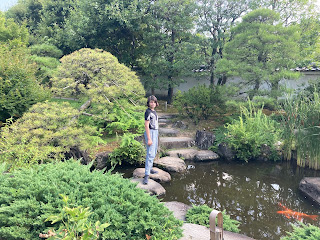It will be another hot day. But all the remaining days will be hot. We booked seats on the Shinkanzen to Himeji, but with the time and hassle of getting from Kobe to Shin-Kobe where the Shinkansen runs, we realize that we might as well take a fast express of the local line. After 45 minutes of train, we arrived in Himeji. As we leave the station, we see the famous castle on the horizon. It’s hot and sunny, so we take the covered walkway to reach the castle. The city is small but nice, and there are people walking around. We reach the moat, take a few pictures, then walk through the front garden to the ticket office. A person checks our temperature, makes sure we disinfect our hands, and kindly warns us that it’s a very hot day,: don’t forget to hydrate, there are machines on the other side of the counter.
The castle is very nice. All white on the outside, wooded on the inside, with a stone base. It is called either the white egret or the white heron, because of its color. It is a rare Japanese castle which did not need to be rebuilt in the 20th century. The visit is very interesting. Himeji Castle is located at a strategic point of the western approach to the ancient capital of Kyoto. The first fortifications built on the site were completed in the 1400s, and were gradually expanded over the centuries by the various clans that ruled the area. The castle complex as it stands today is over 400 years old and was completed in 1609. It consists of more than eighty buildings spread over several baileys, which are connected by a series of gates and winding paths.
The hill on which Himeji Castle was built was first fortified in 1333. The famous castle was added to the site in 1581 CE by the military leader Toyotomi Hideyoshi (1537-1598) who added the first version of the castle keep (tenshu) which was only three stories high. This type of castle, built on a hill and surrounded by a wide plain, is known as hirayamajiro. The castle was remodeled between 1601 and 1609 by the daimyo or feudal lord, Ikeda Terumasa (1564-1613), and the keep was made even higher. This is largely the form we can see today, although some outbuildings were added to the site in 1618 CE. Himeji Castle, like other medieval castles elsewhere, served as a private residence, a garrison for troops, an armory, an administrative and political center, a place where the arts could be created and enjoyed, and a symbol of power and prestige for its builder and resident lord. The castle not only controlled the surrounding countryside, but also protected the western approach to the then capital, Heiankyo (Kyoto).
We start the visit of the castle a little before noon by entering (to escape the sun) the western bailey, and can read a little about the history of the castle and the princess Sen-Hime. She lived a long life, but not always happily. The visit is done without shoes, as always, and we walk on beautiful wooden floors. We then go out (putting our shoes back on) and walk to the main keep. On the way, and considering the heat, we really understand that the castle is built in height. The huge keep rises 46 m high from the center of the inner courtyard of the castle (hommaru). The keep is an example of the connected tower structure found in Japanese castle architecture, where the main tower is connected by passages to several secondary towers (yagura). Two huge wooden columns and a massive stone foundation provide structural support for the tower. Although the interior of the tower has six floors and a basement, from the outside it appears that there are only five floors, as the fourth and fifth floors appear to be merged. The lowest floor has large drop holes built into the overhangs at the corners of the structure, through which defenders can drop nasty things on attackers. The roofs elegantly mix two types of traditional gables: curved kara hafu and triangular chidori hafu.
We finish the visit at 3:30pm feeling hungry, so we move on the the Koko-En garden, which are much more recent but were meant to complement the castle. The garden opened in 1992 on the former site of the feudal lord’s west residence (Nishi-Oyashiki). It consists of nine separate, walled, gardens designed in various styles of the Edo Period. Unfortunately the tea-house is already closed, so we visit with empty stomachs. We resist, as the visit is well worth it. After enjoying these sights, we decide to have a macha ice-cream for some, mochi for others, then walk back to the train station to ride back to Kobe. Noe has realized jeans will not be welcome on this trip, what with the heat, so once we arrive in Kobe we head to Uniqlo where she buys lighter pants. Samuel takes advantage to buy quick drying T-shirts: we now understand quite well why Japanese brand are at the edge of technology regarding this type of clothing! We walk a bit more, passing through Kobe’s Chinatown, to reach a craft beer place. We eat a bit, then the kids take the train back to the hotel while Noe et Samuel go looking for some more food.














Leave a Reply